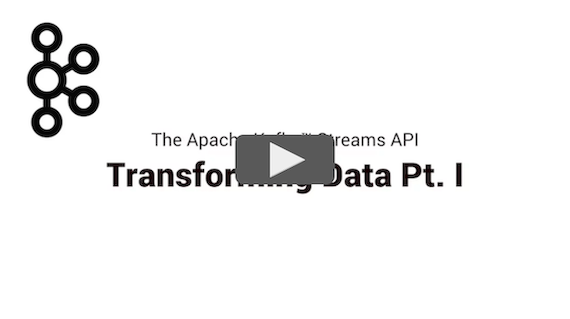Kafka Streams
The easiest way to write mission-critical real-time applications and microservices
Kafka Streams is a client library for building applications and microservices, where the input and output data are stored in Kafka clusters. It combines the simplicity of writing and deploying standard Java and Scala applications on the client side with the benefits of Kafka's server-side cluster technology.
 (Clicking the image will load a video from YouTube)
(Clicking the image will load a video from YouTube)
 (Clicking the image will load a video from YouTube)
(Clicking the image will load a video from YouTube)
 (Clicking the image will load a video from YouTube)
(Clicking the image will load a video from YouTube)
 (Clicking the image will load a video from YouTube)
(Clicking the image will load a video from YouTube)
TOUR OF THE STREAMS API
1Intro to Streams
2Creating a Streams Application
3Transforming Data Pt. 1
4Transforming Data Pt. 2
Why you'll love using Kafka Streams!
- Elastic, highly scalable, fault-tolerant
- Deploy to containers, VMs, bare metal, cloud
- Equally viable for small, medium, & large use cases
- Fully integrated with Kafka security
- Write standard Java and Scala applications
- Exactly-once processing semantics
- No separate processing cluster required
- Develop on Mac, Linux, Windows
Kafka Streams use cases
The New York Times uses Apache Kafka and the Kafka Streams to store and distribute, in real-time, published content to the various applications and systems that make it available to the readers.
As the leading online fashion retailer in Europe, Zalando uses Kafka as an ESB (Enterprise Service Bus), which helps us in transitioning from a monolithic to a micro services architecture. Using Kafka for processing event streams enables our technical team to do near-real time business intelligence.
LINE uses Apache Kafka as a central datahub for our services to communicate to one another. Hundreds of billions of messages are produced daily and are used to execute various business logic, threat detection, search indexing and data analysis. LINE leverages Kafka Streams to reliably transform and filter topics enabling sub topics consumers can efficiently consume, meanwhile retaining easy maintainability thanks to its sophisticated yet minimal code base.
Pinterest uses Apache Kafka and the Kafka Streams at large scale to power the real-time, predictive budgeting system of their advertising infrastructure. With Kafka Streams, spend predictions are more accurate than ever.
Rabobank is one of the 3 largest banks in the Netherlands. Its digital nervous system, the Business Event Bus, is powered by Apache Kafka. It is used by an increasing amount of financial processes and services, one of which is Rabo Alerts. This service alerts customers in real-time upon financial events and is built using Kafka Streams.
Trivago is a global hotel search platform. We are focused on reshaping the way travelers search for and compare hotels, while enabling hotel advertisers to grow their businesses by providing access to a broad audience of travelers via our websites and apps. As of 2017, we offer access to approximately 1.8 million hotels and other accommodations in over 190 countries. We use Kafka, Kafka Connect, and Kafka Streams to enable our developers to access data freely in the company. Kafka Streams powers parts of our analytics pipeline and delivers endless options to explore and operate on the data sources we have at hand.
Hello Kafka Streams
The code example below implements a WordCount application that is elastic, highly scalable, fault-tolerant, stateful, and ready to run in production at large scale
import org.apache.kafka.common.serialization.Serdes;
import org.apache.kafka.common.utils.Bytes;
import org.apache.kafka.streams.KafkaStreams;
import org.apache.kafka.streams.StreamsBuilder;
import org.apache.kafka.streams.StreamsConfig;
import org.apache.kafka.streams.kstream.KStream;
import org.apache.kafka.streams.kstream.KTable;
import org.apache.kafka.streams.kstream.Materialized;
import org.apache.kafka.streams.kstream.Produced;
import org.apache.kafka.streams.state.KeyValueStore;
import java.util.Arrays;
import java.util.Properties;
public class WordCountApplication {
public static void main(final String[] args) throws Exception {
Properties props = new Properties();
props.put(StreamsConfig.APPLICATION_ID_CONFIG, "wordcount-application");
props.put(StreamsConfig.BOOTSTRAP_SERVERS_CONFIG, "kafka-broker1:9092");
props.put(StreamsConfig.DEFAULT_KEY_SERDE_CLASS_CONFIG, Serdes.String().getClass());
props.put(StreamsConfig.DEFAULT_VALUE_SERDE_CLASS_CONFIG, Serdes.String().getClass());
StreamsBuilder builder = new StreamsBuilder();
KStream<String, String> textLines = builder.stream("TextLinesTopic");
KTable<String, Long> wordCounts = textLines
.flatMapValues(textLine -> Arrays.asList(textLine.toLowerCase().split("\\W+")))
.groupBy((key, word) -> word)
.count(Materialized.<String, Long, KeyValueStore<Bytes, byte[]>>as("counts-store"));
wordCounts.toStream().to("WordsWithCountsTopic", Produced.with(Serdes.String(), Serdes.Long()));
KafkaStreams streams = new KafkaStreams(builder.build(), props);
streams.start();
}
}import java.util.Properties
import java.util.concurrent.TimeUnit
import org.apache.kafka.streams.kstream.Materialized
import org.apache.kafka.streams.scala.ImplicitConversions._
import org.apache.kafka.streams.scala._
import org.apache.kafka.streams.scala.kstream._
import org.apache.kafka.streams.{KafkaStreams, StreamsConfig}
object WordCountApplication extends App {
import Serdes._
val props: Properties = {
val p = new Properties()
p.put(StreamsConfig.APPLICATION_ID_CONFIG, "wordcount-application")
p.put(StreamsConfig.BOOTSTRAP_SERVERS_CONFIG, "kafka-broker1:9092")
p
}
val builder: StreamsBuilder = new StreamsBuilder
val textLines: KStream[String, String] = builder.stream[String, String]("TextLinesTopic")
val wordCounts: KTable[String, Long] = textLines
.flatMapValues(textLine => textLine.toLowerCase.split("\\W+"))
.groupBy((_, word) => word)
.count()(Materialized.as("counts-store"))
wordCounts.toStream.to("WordsWithCountsTopic")
val streams: KafkaStreams = new KafkaStreams(builder.build(), props)
streams.start()
sys.ShutdownHookThread {
streams.close(10, TimeUnit.SECONDS)
}
}